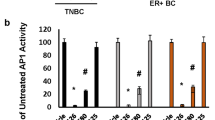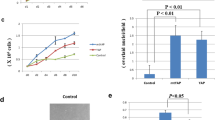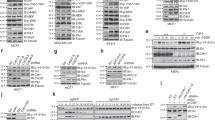Abstract
The activity of protein kinase B, also known as Akt, is commonly elevated in human malignancies and plays a crucial role in oncogenic transformation. The relationship between Akt and the mitogen-activated protein kinase cascade, which is also frequently associated with oncogenesis, remains controversial. We report here examples of cooperation between Akt and cRaf in oncogenic transformation, which was accompanied by elevated activity of extracellular signal-regulated mitogen-activated protein kinases. The effect of Akt on extracellular signal-regulated kinases depended on the status of p21-activated kinase (PAK). Importantly, disruption of the function of PAK not only uncoupled the activation of Akt from that of extracellular signal-regulated kinases, but also greatly reduced the capacity of Akt to act as a transforming oncogene. For the malignancies with hyperactive Akt, our observations support the role for PAK-1 as a potential target for therapeutic intervention.
This is a preview of subscription content, access via your institution
Access options
Subscribe to this journal
Receive 50 print issues and online access
$259.00 per year
only $5.18 per issue
Buy this article
- Purchase on Springer Link
- Instant access to full article PDF
Prices may be subject to local taxes which are calculated during checkout



Similar content being viewed by others
References
Bereiter-Hahn J, Munnich A, Woiteneck P . (1998). Dependence of energy metabolism on the density of cells in culture. Cell Struct Funct 23: 85–93.
Chaudhary A, King WG, Mattaliano MD, Frost JA, Diaz B, Morrison DK et al. (2000). Phosphatidylinositol 3-kinase regulates Raf1 through Pak phosphorylation of serine 338. Curr Biol 10: 551–554.
Euhus DM, Hudd C, LaRegina MC, Johnson FE . (1986). Tumor measurement in the nude mouse. J Surg Oncol 31: 229–234.
Galang CK, García-Ramírez JJ, Solski PA, Westwick JK, Der CJ, Neznanov NN et al. (1996). Oncogenic Neu/ErbB-2 increases Ets, AP-1, and NF-kappaB-dependent gene expression, and inhibiting Ets activation blocks neu-mediated cellular transformation. J Biol Chem 271: 7992–7998.
Galetic I, Maira SM, Andjelkovic M, Hemmings BA . (2003). Negative regulation of ERK and Elk by protein kinase B modulates c-Fos transcription. J Biol Chem 278: 4416–4423.
Gartel AL, Kandel ES . (2006). RNA interference in cancer. Biomol Eng 23: 17–34.
Kandel ES, Hay N . (1999). The regulation and activities of the multifunctional serine/threonine kinase Akt/PKB. Exp Cell Res 253: 210–229.
Kandel ES, Skeen J, Majewski N, Di Cristofano A, Pandolfi PP, Feliciano CS et al. (2002). Activation of Akt/protein kinase B overcomes a G(2)/m cell cycle checkpoint induced by DNA damage. Mol Cell Biol 22: 7831–7841.
Kennedy SG, Kandel ES, Cross TK, Hay N . (1999). Akt/Protein kinase B inhibits cell death by preventing the release of cytochrome c from mitochondria. Mol Cell Biol 19: 5800–5810.
King AJ, Sun H, Diaz B, Barnard D, Miao W, Bagrodia S et al. (1998). The protein kinase Pak3 positively regulates Raf-1 activity through phosphorylation of serine 338. Nature 396: 180–183.
Leevers SJ, Paterson HF, Marshall CJ . (1994). Requirement for Ras in Raf activation is overcome by targeting Raf to the plasma membrane. Nature 369: 411–414.
McCubrey JA, Lee JT, Steelman LS, Blalock WL, Moye PW, Chang F et al. (2001). Interactions between the PI3 K and Raf signaling pathways can result in the transformation of hematopoietic cells. Cancer Detect Prev 25: 375–393.
McCubrey JA, Steelman LS, Abrams SL, Lee JT, Chang F, Bertrand FE et al. (2006). Roles of the RAF/MEK/ERK and PI3K/PTEN/AKT pathways in malignant transformation and drug resistance. Adv Enzyme Regul 46: 249–279.
Mirza AM, Gysin S, Malek N, Nakayama K-I, Roberts JM, McMahon M . (2004). Cooperative regulation of the cell division cycle by the protein kinases RAF and AKT. Mol Cell Biol 24: 10868–10881.
Mirza AM, Kohn AD, Roth RA, McMahon M . (2000). Oncogenic transformation of cells by a conditionally active form of the protein kinase Akt/PKB. Cell Growth Differ 11: 279–292.
Moelling K, Schad K, Bosse M, Zimmermann S, Schweneker M . (2002). Regulation of Raf-Akt cross-talk. J Biol Chem 277: 31099–31106.
Morgenstern JP, Land H . (1990). Advanced mammalian gene transfer: high titre retroviral vectors with multiple drug selection markers and a complementary helper-free packaging cell line. Nucleic Acids Res 18: 3587–3596.
Nheu T, He H, Hirokawa Y, Walker F, Wood J, Maruta H . (2004). PAK is essential for RAS-induced upregulation of cyclin D1 during the G1 to S transition. Cell Cycle 3: 71–74.
Roberts PJ, Der CJ . (2007). Targeting the Raf-MEK-ERK mitogen-activated protein kinase cascade for the treatment of cancer. Oncogene 26: 3291–3310.
Shelton JG, Blalock WL, White ER, Steelman LS, McCubrey JA . (2004). Ability of the activated PI3K/Akt oncoproteins to synergize with MEK1 and induce cell cycle progression and abrogate the cytokine-dependence of hematopoietic cells. Cell Cycle 3: 503–512.
Sheng H, Shao J, DuBois RN . (2001). Akt/PKB activity is required for Ha-Ras-mediated transformation of intestinal epithelial cells. J Biol Chem 276: 14498–14504.
Somanath PR, Byzova TV . (2009). 14-3-3beta-Rac1-p21 activated kinase signaling regulates Akt1-mediated cytoskeletal organization, lamellipodia formation and fibronectin matrix assembly. J Cell Physiol 218: 394–404.
Stokoe D, Macdonald SG, Cadwallader K, Symons M, Hancock JF . (1994). Activation of Raf as a result of recruitment to the plasma membrane. Science 264: 1463–1467.
Sun H, King AJ, Diaz HB, Marshall MS . (2000). Regulation of the protein kinase Raf-1 by oncogenic Ras through phosphatidylinositol 3-kinase, Cdc42/Rac and Pak. Current Biology 10: 281–284.
Tang Y, Chen Z, Ambrose D, Liu J, Gibbs JB, Chernoff J et al. (1997). Kinase-deficient Pak1 mutants inhibit Ras transformation of Rat-1 fibroblasts. Mol Cell Biol 17: 4454–4464.
Weinberg RA . (2007). The Biology of Cancer. Garland Science: New York.
Yuan TL, Cantley LC . (2008). PI3K pathway alterations in cancer: variations on a theme. Oncogene 27: 5497–5510.
Zimmermann S, Moelling K . (1999). Phosphorylation and regulation of Raf by Akt (protein kinase B). Science 286: 1741–1744.
Acknowledgements
We thank Dr Nikolay Neznanov for the Ets-reporter construct, Dr Channing Der for RIE-1 cells, Dr George Stark for the MEF cells and Dr Nissim Hay for various Akt-expressing constructs. This work was supported by the Howard Temin Award to ESK, NIH Grant HL071625 to TB and American Heart Association grant 0830326N to PRS.
Author information
Authors and Affiliations
Corresponding author
Rights and permissions
About this article
Cite this article
Somanath, P., Vijai, J., Kichina, J. et al. The role of PAK-1 in activation of MAP kinase cascade and oncogenic transformation by Akt. Oncogene 28, 2365–2369 (2009). https://doi.org/10.1038/onc.2009.114
Received:
Revised:
Accepted:
Published:
Issue Date:
DOI: https://doi.org/10.1038/onc.2009.114
Keywords
This article is cited by
-
Expression of Marker PAK1 in Sinonasal Polyposis
Indian Journal of Otolaryngology and Head & Neck Surgery (2022)
-
Endothelial Akt1 loss promotes prostate cancer metastasis via β-catenin-regulated tight-junction protein turnover
British Journal of Cancer (2018)
-
Direct binding of MEK1 and MEK2 to AKT induces Foxo1 phosphorylation, cellular migration and metastasis
Scientific Reports (2017)
-
An RNA interference screen identifies new avenues for nephroprotection
Cell Death & Differentiation (2016)
-
TNFα induces inflammatory stress response in microvascular endothelial cells via Akt- and P38 MAP kinase-mediated thrombospondin-1 expression
Molecular and Cellular Biochemistry (2015)



